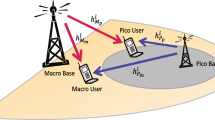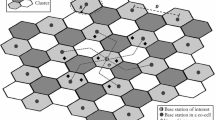Abstract
In cellular mobile radio systems, interference is a limiting factor with respect to both system performance and system capacity. Therefore, profound knowledge of the statistics of the carrier-to-interference ratio C/I, given by the received carrier power C and the sum I of received powers associated with various interferers, is essential. In this communication, a general approach allowing the calculation of C/I for both the up- and the downlink of any interference limited mobile radio system is presented. Power control algorithms are explicitly considered. The general approach is used to provide insight into the statistics of C/I of C/TDMA systems applying multi-user detection, which are promising candidates for third generation mobile radio systems. For these C/TDMA systems applying multi-user detection, a representative selection of results is collected from the general approach and presented in this communication. Furthermore, results concerning the composition of the intercell interference are given. These results are of particular interest when plumbing potential benefits of worthwhile future enhanced multi-user detection schemes which explicitly incorporate a given number of intercell interferers.
Similar content being viewed by others
References
B. Frison, M. Woinsky and A. Kripalani, “PCS standards,” IEEE Personal Communications Magazine, special issue, Vol. 1, No. 4, 1994.
D. Grillo, S.T.S. Chia and N. Ruelle, “The european path towards UMTS,” IEEE Personal Communications Magazine, special issue, Vol. 2, No. 1, 1995.
P.W. Baier, P. Jung and A. Klein, “Taking the challenge of multiple access for third generation cellular mobile radio systems - a european view,” IEEE Communications Magazine, Vol. 34, No. 2, pp. 82–89, 1996.
P.W. Baier, “CDMA or TDMA? CDMA for GSM?” in Proc. IEEE International Symposium on Personal, Indoor and Mobile Radio Communications (PIMRC '94), The Hague, pp. 1280–1284, 1994.
M. Mouly and M.B. Pautet, The GSM-system for mobile communications. Published by the authors, 1992.
K. Raith and J. Uddenfeld, “Capacity of digital cellular TDMA systems,” IEEE Transactions on Vehicular Technology, VT-40, pp. 323–332, 1991.
N. Metzner, F. David and Eul H.-J., “A realtime testbed for a third generation mobile communication system,” in Proc. of the 44th IEEE Vehicular Technology Conference (VTC '94), Stockholm, pp. 1336–1340, 1994.
D. Cygan, F. David, H.-J. Eul, J. Hofmann, N. Metzner and W. Mohr, “RACE-II advanced TDMA mobile access project - an approach for UMTS, in Proc. of the 1994 International Zurich Seminar on Digital Communications, Zurich, pp. 428–439, 1994.
J.A. Schwarz da Silva, “Mobile and personal communications in ACTS,” in Proc. of the 5th International Symposium on Personal, Indoor, and Mobile Radio Communications (PIMRC '94), Den Haag, pp. 1292–1299, 1994.
A. Schiml, “Interference analysis in the GSM system,” in Proc. of the 44th IEEE Vehicular Technology Conference (VTC '94), Stockholm, pp. 686–690, 1994.
V.H. Mac Donald, “The cellular concept,” The Bell System Technical Journal, Vol. 58 No. 1, pp. 15–42, 1979.
J. Rapeli, “UMTS-targets, system concept and standardization in a global framework,” IEEE Personal Communications Magazine, Vol. 2, No. 1, pp. 44–55, 1995.
A. Baier, U.-C. Fiebig, W. Granzow, W. Koch, P. Teder and J. Thielecke, “Design study for a CDMA based third generation mobile radio system,” IEEE Journal on Selected Areas in Communications, Vol. 12, pp. 733–743, 1994.
G.R. Cooper and R.W. Nettleton, “A spread spectrum technique for high-capacity mobile communications,” IEEE Transactions on Vehicular Technology, VT-27, pp. 264–275, 1978.
K.S. Gilhousen, I.M. Jacobs, R. Padovani, A.J. Viterbi, L.A. Weaver and C.E. Wheatly. “On the capacity of a cellular CDMA system,” IEEE Transactions on Vehicular Technology, VT-40, pp. 303–312, 1991.
A. Klein, G.K. Kaleh and P.W. Baier, “Equalizers for multi-user detection in code division multiple access mobile radio systems,” in Proc. of the 44th IEEE Vehicular Technology Conference (VTC '94), Stockholm, pp. 762–766, 1994.
S. Verdú, “Adaptive multiuser detection,” in Proc. IEEE Third International Symposium on Spread Spectrum Techniques and Applications (ISSSTA '94), Oulu, pp. 43–50, 1994.
A. Klein and P.W. Baier, “Linear unbiased data estimation in mobile radio systems applying CDMA,” IEEE Journal on Selected Areas in Communications, Vol. 11, pp. 1058–1066, 1993.
P. Jung and B. Steiner, “A joint detection CDMA mobile radio system concept developed within COST 231,” in Proc. of the 45th IEEE Vehicular Technology Conference (VTC '95),Chicago, pp. 469–473, 1995.
M. Naßhan, P. Jung, A. Steil and P.W. Baier, “On the effects of quantization, nonlinear amplification and band-limitation in CDMA mobile radio systems using joint detection,” in Proc. International Conference on Wireless Communications (Wireless '93), Calgary, pp. 173–186, 1993.
P. Jung, J.J. Blanz and P.W. Baier, “Coherent receiver antenna diversity for CDMA mobile radio systems using joint detection,” in Proc. IEEE International Symposium on Personal, Indoor and Mobile Radio Communications (PIMRC '93), Yokohama, pp. 488–492, 1993.
J.J. Blanz, A. Klein, M. Naßhan and A. Steil, “Performance of a cellular hybrid C/TDMA mobile radio system applying joint detection and coherent receiver antenna diversity,” IEEE Journal on Selected Areas in Communications, Vol. 12, pp. 568–579, 1994.
M. Naßhan, A. Steil, A. Klein and P. Jung, “Downlink cellular mobile radio capacity of a joint detection CDMA mobile radio system,” in Proc. of the 45th IEEE Vehicular Technology Conference (VTC '95), Chicago, pp. 474–478, 1995.
J.M. Aein, “Power balancing in systems employing frequency reuse,” COMSAT Tech. Rev., Vol. 3, No. 2, 1973.
R.W. Nettleton and H. Alavi, “Downstream power control for spread spectrum cellular mobile radio systems,” in Proc. Globecom '82, Miami, pp. 84–88, 1982.
R.W. Nettleton and H. Alavi, “Power control for a spread spectrum cellular mobile radio system,” in Proc. of the 33th IEEE Vehicular Technology Conference (VTC '83), Toronto, pp. 243–246, 1983.
J. Zander, “Performance of optimum transmitter power control in cellular radio systems,” IEEE Transactions on Vehicular Technology, VT-41, pp. 57–62, 1992.
J. Zander, “Distributed cochannel interference control in cellular radio systems,” IEEE Transactions on Vehicular Technology, VT-41, pp. 305–311, 1992.
S.A. Grandhi, R. Vijayan, D.J. Goodman and J. Zander, “Centralized power control in cellular radio systems,” IEEE Transactions on Vehicular Technology, VT-42, pp. 466–468, 1993.
S.A. Grandhi, R. Vijayan and D.J. Goodman, “Distributed power control in cellular radio systems,” IEEE Transactions on Communications, COM-42, pp. 226–228, 1994.
S.A. Grandhi and J. Zander, “Constrained power control in cellular systems,” in Proc. of the 44th IEEE Vehicular Technology Conference (VTC '94), Stockholm, pp. 824–828, 1994.
A. Papoulis, Probability, random variables and stochastic processes, McGraw-Hill, Singapore, 1989.
P.A. Ranta, Z-C. Honkasalo and J. Tapaninen, “TDMA cellular network application of an interference canellation technique,” in Proc. of the 45th IEEE Vehicular Technology Conference (VTC 95), Chicago, pp. 296–300, 1995.
G. Grawert, Quantenmechanik, Akademische Verlagsgesellschaft, 3., korrigierte Auflage, Wiesbaden, 1977.
H. Minc, Nonnegative Matrices, John Wiley and Sons, New York, 1988.
R. Zurmühl, Matrizen, Springer-Verlag, Berlin, 1964.
R. Steele, Mobile radio communications, Pentech Press, London, 1992.
J.D. Parsons, The mobile radio propagation channel, Pentech Press, London, 1992.
A.M. Viterbi and A.J. Viterbi, “Erlang capacity of a power controlled CDMA system,” IEEE Journal on Selected Areas in Communications, Vol. 11, pp. 892–900, 1993.
J.J. Blanz, P. Jung, A. Steil and P.W. Baier, “Coherent receiver antenna diversity with directional antennas,” in Proc. of the IEEE International Conference on Telecommunications (ICT '96), Istanbul, pp. 410–417, 1996.
A. Steil and J.J. Blanz, “Spectral efficiency of JD-CDMA mobile radio systems applying coherent receiver antenna diversity with directional antennas,” in Proc. IEEE Fourth International Symposium on Spread Spectrum Techniques and Applications (ISSSTA '96), Mainz, pp. 313–319, 1996.
Author information
Authors and Affiliations
Rights and permissions
About this article
Cite this article
Steil, A. Statistics of the Carrier-to-Interference Ratio in C/TDMA Cellular Mobile Radio Systems Applying Multi-User Detection. Wireless Personal Communications 5, 259–277 (1997). https://doi.org/10.1023/A:1008850632123
Issue Date:
DOI: https://doi.org/10.1023/A:1008850632123




